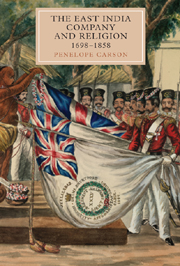Book contents
- Frontmatter
- Contents
- Acknowledgements
- Note on Hinduism
- Abbreviations
- Map of India
- Introduction
- 1 A Christian Company?
- 2 The East India Company, Britain and India 1770–1790
- 3 The 1790s: A Time of Crisis
- 4 The Pillar of Fire Moves Forward: The Advent of British Missionaries 1793–1806
- 5 The Wisdom of the Serpent and the Innocence of the Dove: The Vellore Mutiny and the Pamphlet War 1806–1808
- 6 Troubled Years 1807–1812
- 7 Battle Lines Drawn: Missions, Dissent and the Establishment
- 8 The 1813 Renewal of the Company's Charter: The Religious Public Takes on the Company
- 9 A Turbulent Frontier: The Company and Religion 1814–1828
- 10 A New Dawn? The Era of Lord William Bentinck 1828–1835
- 11 Between Scylla and Charibdis 1836–1858
- Conclusion and Epilogue: Strangers in the Land
- Appendix 1 Presidents of the Board of Control
- Appendix 2 Governors-General and Governors of Madras and Bombay
- Appendix 3 Aide Memoire to Names
- Appendix 4 ‘The Pious Clause’
- Bibliography
- Index
- WORLDS OF THE EAST INDIA COMPANY
5 - The Wisdom of the Serpent and the Innocence of the Dove: The Vellore Mutiny and the Pamphlet War 1806–1808
Published online by Cambridge University Press: 05 February 2013
- Frontmatter
- Contents
- Acknowledgements
- Note on Hinduism
- Abbreviations
- Map of India
- Introduction
- 1 A Christian Company?
- 2 The East India Company, Britain and India 1770–1790
- 3 The 1790s: A Time of Crisis
- 4 The Pillar of Fire Moves Forward: The Advent of British Missionaries 1793–1806
- 5 The Wisdom of the Serpent and the Innocence of the Dove: The Vellore Mutiny and the Pamphlet War 1806–1808
- 6 Troubled Years 1807–1812
- 7 Battle Lines Drawn: Missions, Dissent and the Establishment
- 8 The 1813 Renewal of the Company's Charter: The Religious Public Takes on the Company
- 9 A Turbulent Frontier: The Company and Religion 1814–1828
- 10 A New Dawn? The Era of Lord William Bentinck 1828–1835
- 11 Between Scylla and Charibdis 1836–1858
- Conclusion and Epilogue: Strangers in the Land
- Appendix 1 Presidents of the Board of Control
- Appendix 2 Governors-General and Governors of Madras and Bombay
- Appendix 3 Aide Memoire to Names
- Appendix 4 ‘The Pious Clause’
- Bibliography
- Index
- WORLDS OF THE EAST INDIA COMPANY
Summary
No danger can be so extreme … as the prevalence of an apprehension among our Native Subjects that the Government meditates the project of their Conversion.
(George Barlow)TWO HOURS after midnight on 10 July 1806, sepoys crept up and murdered the European sentries at Vellore fort, where Tipu Sultan's family were state prisoners. The European quarters were surrounded and officers and soldiers in the barracks, including those in the hospital, were shot. The striped tiger of Mysore was hoisted. This revolt was put down very swiftly but not before the toll of dead and wounded on the British side was nearly 200. Shortly afterwards further disturbances occurred in Madras Presidency at Wallahjabad, Nundidrug, Bellary, Hyderabad, Palamcottah, Quilon and Bangalore. The sepoy mutiny sent shock waves through India and even more in Britain when news of it reached there in February the following year. Opponents of missionary activity seized on the mutiny as proof that their arguments that Indian religious prejudices were easily excited were only too true and that the greatest caution was needed in any interference with them. Grant and Parry had a battle on their hands to persuade the opposition that extreme action should not be taken against missionaries.
The causes of the Vellore Mutiny were a matter of fierce contention then and controversy over them continues to this day. Lord William Bentinck, Governor of Madras at the time, placed chief blame on the introduction of new dress regulations for the sepoys.
- Type
- Chapter
- Information
- The East India Company and Religion, 1698-1858 , pp. 70 - 89Publisher: Boydell & BrewerPrint publication year: 2012



